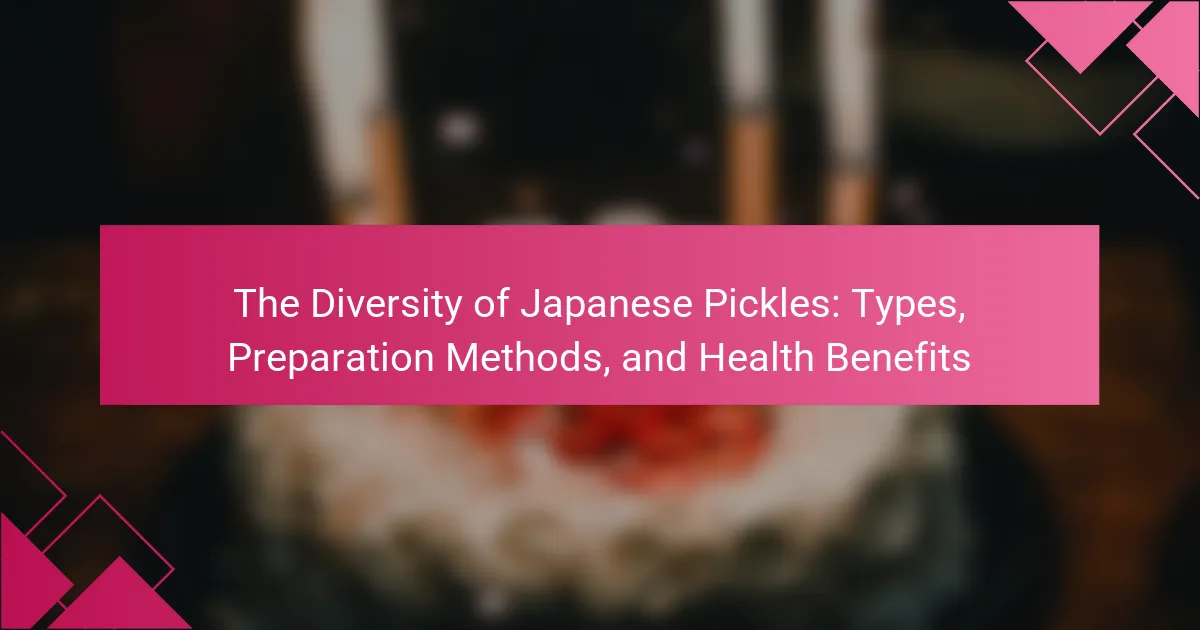
What are Japanese Pickles and Their Significance?
Japanese pickles, known as “tsukemono,” are a variety of preserved vegetables. They are integral to Japanese cuisine, often served as side dishes. Tsukemono can be made from cucumbers, radishes, and eggplants, among other vegetables. The preservation process typically involves fermentation, salting, or pickling in vinegar.
These pickles provide a burst of flavor and texture to meals. They also aid in digestion due to their probiotic content. Historically, tsukemono have been consumed for centuries, serving as a way to preserve seasonal vegetables. Their significance extends beyond taste; they represent cultural heritage and seasonal eating in Japan.
How are Japanese pickles different from other types of pickles?
Japanese pickles, known as tsukemono, differ from other types of pickles primarily in their ingredients and preparation methods. They often utilize a variety of vegetables, including daikon, cucumbers, and eggplant. The pickling process typically involves fermentation with rice bran, salt, or vinegar, which can take days to months.
Unlike Western pickles, which often rely on vinegar-based brines, Japanese pickles emphasize natural fermentation. This method enhances the flavor complexity and nutritional profile of the vegetables. Additionally, Japanese pickles are often consumed as side dishes, providing a balance to rice and other main dishes.
Many types of tsukemono are seasoned with unique flavors, such as shiso leaves or chili peppers, contributing to their distinct taste. The cultural significance of tsukemono in Japanese cuisine is profound, often representing seasonal changes and regional specialties.
What cultural role do Japanese pickles play in Japanese cuisine?
Japanese pickles, known as tsukemono, play a significant cultural role in Japanese cuisine. They are served as side dishes, enhancing the flavor of main meals. Tsukemono are often enjoyed with rice, providing balance and contrast. Traditionally, they symbolize hospitality and are offered to guests. The variety of pickles reflects regional ingredients and methods, showcasing local culture. Festivals and celebrations frequently feature tsukemono, highlighting their importance in social gatherings. Additionally, they serve as a means of food preservation, extending the shelf life of seasonal vegetables. Overall, Japanese pickles are integral to both daily meals and cultural practices in Japan.
Why are Japanese pickles considered a staple in Japanese meals?
Japanese pickles are considered a staple in Japanese meals due to their ability to enhance flavor and provide balance. They serve as a palate cleanser, complementing rice and main dishes. Pickles also contribute to the overall nutrition of meals, offering vitamins and probiotics. Historically, they have been used for preservation, extending the shelf life of vegetables. The variety of flavors and textures in Japanese pickles adds diversity to the dining experience. Common types like tsukemono are often served with every meal, reinforcing their cultural significance. Their role in traditional Japanese cuisine is well-documented, highlighting their importance in daily life.
What are the main types of Japanese pickles?
The main types of Japanese pickles include tsukemono, nukazuke, and shiozuke. Tsukemono refers to a broad category of pickled vegetables. Nukazuke involves fermenting vegetables in rice bran. Shiozuke uses salt for preservation and flavor. Other notable types are karasuzuke, which is pickled in soy sauce, and amazu-zuke, which is pickled in sweet vinegar. Each type varies in flavor, texture, and preparation method. Japanese pickles are integral to traditional meals, often served as side dishes. They contribute to the overall balance of flavors in Japanese cuisine.
What are the characteristics of Tsukemono?
Tsukemono are traditional Japanese pickles known for their distinct flavors and preservation methods. They are typically made from a variety of vegetables, including cucumbers, radishes, and eggplant. Tsukemono can be classified into several types, such as shiozuke (salt-pickled), suzuke (vinegar-pickled), and morozuke (frozen-pickled). They are often characterized by their vibrant colors, crunchy texture, and umami taste. Tsukemono serves as a side dish or condiment, enhancing the overall dining experience. The preservation process involves fermentation or salting, which contributes to their unique taste and health benefits. Additionally, they are low in calories and rich in probiotics, promoting digestive health.
How do different vegetables influence the types of Japanese pickles?
Different vegetables significantly influence the types of Japanese pickles. Each vegetable brings unique flavors, textures, and colors to the pickling process. For instance, cucumbers are commonly used for their crispness and ability to absorb flavors. Daikon radish offers a mild taste and crunchy texture, making it a popular choice for pickling. Carrots provide sweetness and vibrant color, enhancing the visual appeal of pickles.
Additionally, eggplant is often pickled for its soft texture and ability to take on seasonings. The pickling method also varies with the vegetable; for example, quick pickling is often used for cucumbers, while longer fermentation is typical for daikon. The choice of salt and seasoning can also vary based on the vegetable, further diversifying the pickle types. This variety reflects regional preferences and seasonal availability in Japan.

What are the common preparation methods for Japanese pickles?
Common preparation methods for Japanese pickles include salt pickling, vinegar pickling, and fermentation. Salt pickling, known as “shiozuke,” involves rubbing salt on vegetables and allowing them to release moisture. This method enhances flavor and preserves the vegetables. Vinegar pickling, or “suzuke,” uses rice vinegar to marinate vegetables, often resulting in a tangy taste. Fermentation, referred to as “nukazuke,” involves burying vegetables in a rice bran mixture, allowing beneficial bacteria to develop flavors over time. Each method is traditional and contributes to the unique taste and texture of Japanese pickles.
How is the fermentation process utilized in making Japanese pickles?
The fermentation process is essential in making Japanese pickles. It involves using microorganisms to transform vegetables. Common vegetables include cucumbers, radishes, and eggplants. Salt is typically added to create an environment for fermentation. This process promotes the growth of beneficial bacteria, such as Lactobacillus. These bacteria convert sugars in the vegetables into lactic acid. Lactic acid acts as a preservative and enhances flavor. The fermentation period can vary from a few days to several months. This method not only preserves the vegetables but also develops unique tastes and textures.
What ingredients are typically used in the fermentation process?
The ingredients typically used in the fermentation process include salt, water, and microorganisms. Salt is crucial as it inhibits harmful bacteria while allowing beneficial ones to thrive. Water is necessary to dissolve salt and create a brine solution. Microorganisms, such as yeast and lactic acid bacteria, are essential for converting sugars into acids and alcohol during fermentation. These ingredients work together to create the unique flavors and textures found in fermented foods. Fermentation is a time-honored technique used in various cultures, including Japan, for preserving and enhancing the nutritional value of foods.
How does fermentation affect the flavor and texture of pickles?
Fermentation significantly enhances the flavor and texture of pickles. During fermentation, beneficial bacteria break down sugars in cucumbers, producing lactic acid. This process creates a tangy, sour flavor profile typical of fermented pickles. The acidity from lactic acid also helps preserve the pickles, extending their shelf life.
Texture is affected as well; fermentation softens the cucumbers, making them tender yet crisp. The presence of enzymes during fermentation contributes to this change in texture. Studies show that the fermentation process can take anywhere from a few days to several weeks, influencing the final taste and crunchiness of the pickles.
Overall, fermentation transforms cucumbers into flavorful, textured pickles through a complex biochemical process.
What are the quick pickling methods used in Japanese cuisine?
Quick pickling methods used in Japanese cuisine include “asazuke,” “shiozuke,” and “suzuke.” Asazuke involves lightly salting vegetables for a short time. This method enhances flavor while retaining crunchiness. Shiozuke is a salt-pickling technique that uses salt to draw out moisture. It often results in a firmer texture. Suzuke is a vinegar-based pickling method. It typically incorporates rice vinegar, sugar, and salt for a balanced taste. These methods are quick and preserve the natural flavors of the ingredients. They are commonly used for seasonal vegetables in Japanese cooking.
What ingredients are essential for quick pickling?
Essential ingredients for quick pickling include vinegar, water, salt, and sugar. Vinegar provides the necessary acidity for preservation. Water dilutes the vinegar to achieve the desired flavor balance. Salt enhances flavor and acts as a preservative. Sugar adds sweetness, balancing the acidity of the vinegar. Additional flavorings may include spices like mustard seeds or dill. These ingredients create a brine that allows for quick fermentation. Quick pickling typically requires a short time, often just a few hours to overnight, for the vegetables to absorb the flavors.
How do quick pickling methods differ from traditional fermentation?
Quick pickling methods differ from traditional fermentation in their speed and processes. Quick pickling involves using vinegar and salt to create a brine. This method typically requires only a few hours to a couple of days for the food to absorb flavors. In contrast, traditional fermentation relies on natural bacteria and yeasts, taking weeks to months for the fermentation process to occur.
Quick pickling results in a tangy flavor due to the vinegar, while fermentation produces lactic acid, giving fermented foods a distinct sour taste. The quick pickling process is often used for short-term preservation. Traditional fermentation enhances the nutritional profile by developing probiotics over time.
The differences in time, flavor, and preservation techniques highlight the unique qualities of each method.

What health benefits do Japanese pickles offer?
Japanese pickles offer several health benefits. They are rich in probiotics, which support gut health. Probiotics can improve digestion and enhance the immune system. Additionally, Japanese pickles contain vitamins and minerals, contributing to overall nutrition. For example, they often include ingredients like daikon radish, which is high in vitamin C. The fermentation process also increases the bioavailability of nutrients. Some studies suggest that fermented foods may help reduce inflammation. Overall, incorporating Japanese pickles into the diet can promote health and well-being.
How do Japanese pickles contribute to digestive health?
Japanese pickles contribute to digestive health primarily through their probiotic content. These pickles are often fermented, which promotes the growth of beneficial bacteria. The presence of these probiotics aids in maintaining a healthy gut microbiome. A balanced gut microbiome is essential for efficient digestion and nutrient absorption. Additionally, Japanese pickles are typically rich in fiber. Fiber enhances bowel regularity and prevents constipation. Studies indicate that fermented foods can improve gut health markers. For instance, research published in the Journal of Nutrition shows that probiotics can enhance digestion and gut health. Thus, the combination of probiotics and fiber in Japanese pickles supports overall digestive wellness.
What role do probiotics play in the health benefits of fermented pickles?
Probiotics in fermented pickles enhance gut health by introducing beneficial bacteria. These live microorganisms help maintain a balanced microbiome. A healthy microbiome supports digestion and nutrient absorption. Probiotics also boost the immune system, reducing the risk of infections. Research indicates that fermented foods, including pickles, can improve overall health. For instance, a study published in the Journal of Food Science found that probiotics from fermented vegetables can promote digestive health. This reinforces the significance of probiotics in the health benefits of fermented pickles.
How do the nutrients in Japanese pickles support overall health?
Japanese pickles are rich in nutrients that support overall health. They contain probiotics, which promote gut health and improve digestion. These beneficial bacteria can enhance nutrient absorption and boost the immune system. Japanese pickles are also low in calories and high in fiber, aiding in weight management and promoting satiety. Additionally, they are often made from vegetables that provide essential vitamins and minerals. For instance, cucumbers are high in vitamin K, while daikon radish is rich in vitamin C. The fermentation process increases bioavailability of these nutrients, making them easier for the body to absorb. Overall, the combination of probiotics, vitamins, and fiber in Japanese pickles contributes to a balanced diet and supports various bodily functions.
What are some potential drawbacks of consuming Japanese pickles?
Consuming Japanese pickles can lead to several potential drawbacks. High sodium content is a primary concern. Many Japanese pickles are prepared with salt, which can contribute to hypertension. Excessive salt intake is linked to increased blood pressure and cardiovascular issues. Some individuals may experience digestive discomfort from the fermentation process. This can result in bloating or gas for sensitive individuals. Additionally, pickles may contain preservatives or additives that some people prefer to avoid. These substances can cause allergic reactions or sensitivities in certain individuals. Lastly, those with specific dietary restrictions should be cautious, as some pickles may not align with their nutritional needs.
How can high sodium levels in pickles affect health?
High sodium levels in pickles can negatively impact health. Excess sodium intake is linked to increased blood pressure. High blood pressure can lead to heart disease and stroke. The American Heart Association recommends limiting sodium to 2,300 mg per day. Many pickles contain significantly higher levels, sometimes exceeding 1,000 mg per serving. This can contribute to hypertension in susceptible individuals. Additionally, high sodium intake may cause fluid retention. Fluid retention can lead to swelling and discomfort. Monitoring sodium levels in pickles is essential for maintaining overall health.
What should individuals with dietary restrictions consider when consuming pickles?
Individuals with dietary restrictions should consider the ingredients and preparation methods of pickles. Many pickles contain high levels of sodium due to brining. This can be a concern for those with hypertension or heart issues. Additionally, some pickles may use preservatives or additives that can trigger allergies. Individuals should check labels for allergens like gluten or specific spices. Fermented pickles may also contain probiotics, which can be beneficial or harmful depending on one’s digestive health. Lastly, those with specific dietary needs should consult a healthcare provider regarding pickles in their diet.
What are the best practices for incorporating Japanese pickles into your diet?
Incorporating Japanese pickles into your diet can enhance flavor and provide health benefits. Start by using them as a condiment to accompany rice dishes. They add a tangy taste that complements the mildness of the rice. Next, include pickles in salads for added crunch and flavor. This combination can improve the nutritional profile of your meal.
You can also use Japanese pickles in sandwiches or wraps for a unique twist. Their distinct flavor can elevate simple ingredients. Additionally, consider serving them as a side dish with grilled meats or fish. This pairing can enhance the overall dining experience.
Lastly, experiment with different types of pickles to discover your preferences. Varieties like tsukemono offer diverse tastes and textures. Regular consumption can support digestive health due to their probiotic content.
Japanese pickles, or “tsukemono,” are a diverse category of preserved vegetables integral to Japanese cuisine, made through methods such as fermentation, salting, and vinegar pickling. This article explores the various types of tsukemono, including their unique preparation methods and the cultural significance they hold in Japan, highlighting their role as side dishes that enhance meals. Additionally, it discusses the health benefits of Japanese pickles, particularly their probiotic content and nutritional value, while also addressing potential drawbacks such as high sodium levels. Readers will gain insights into how different vegetables influence the types of pickles and best practices for incorporating them into a balanced diet.
